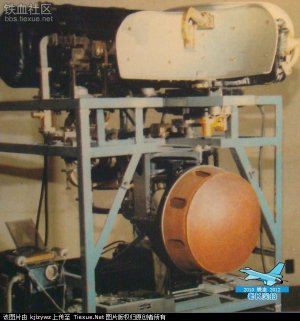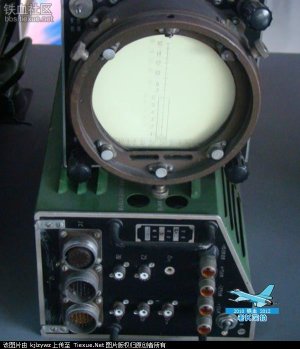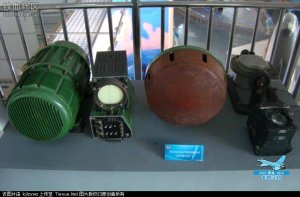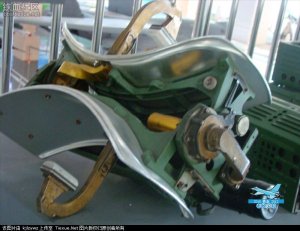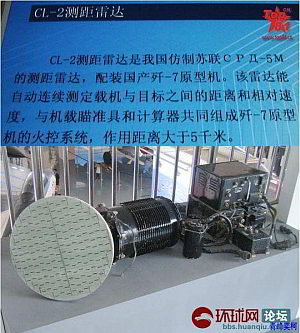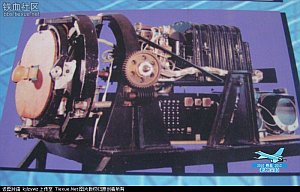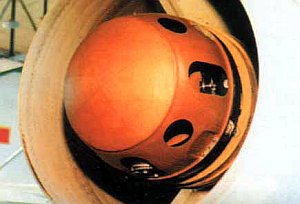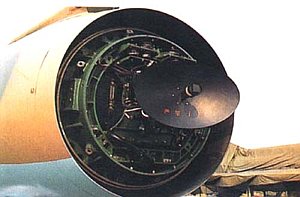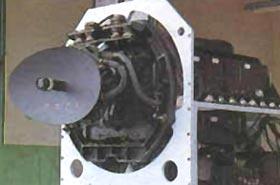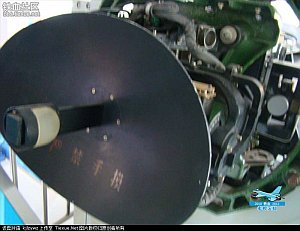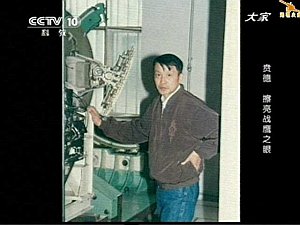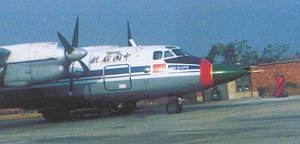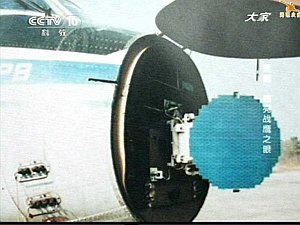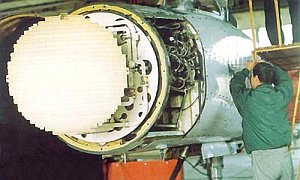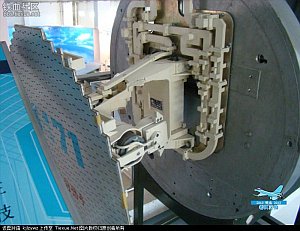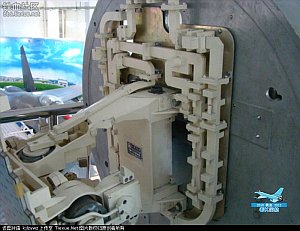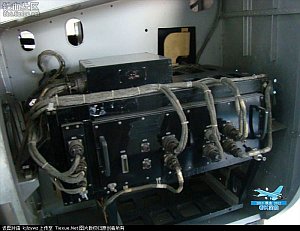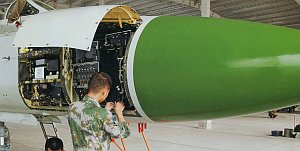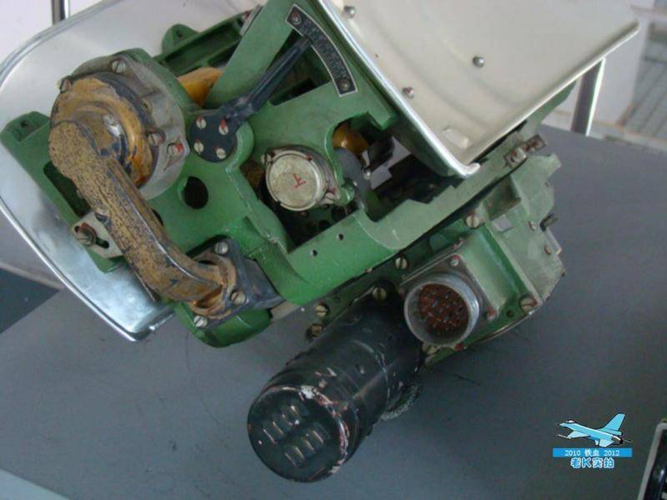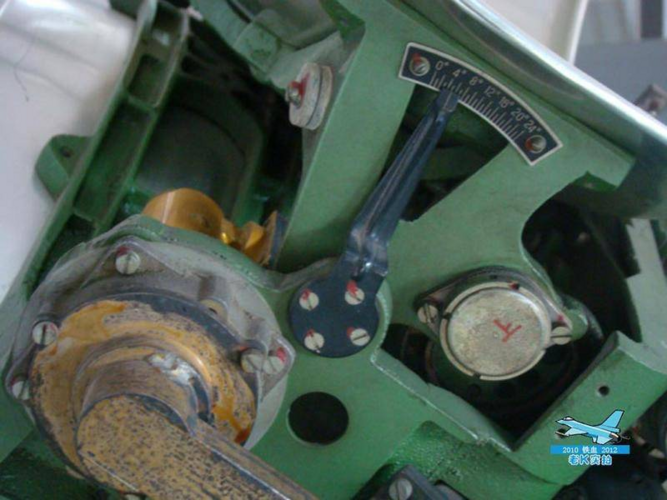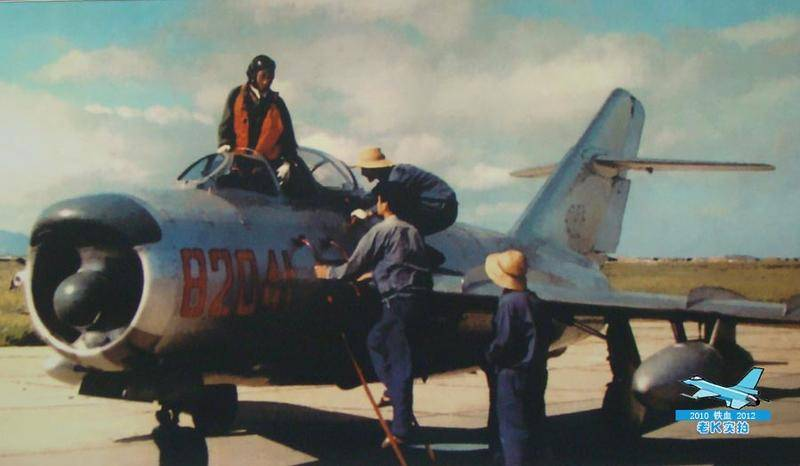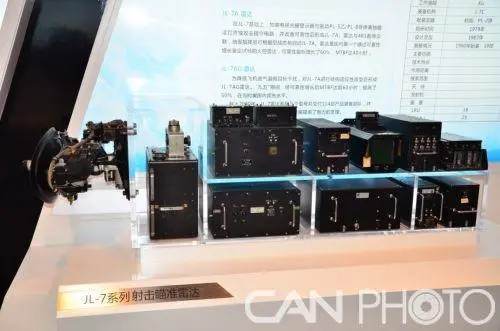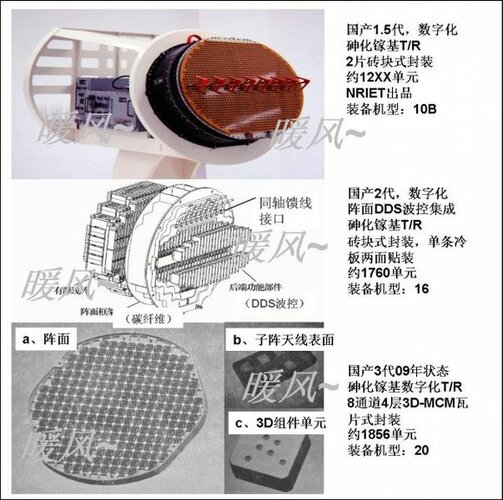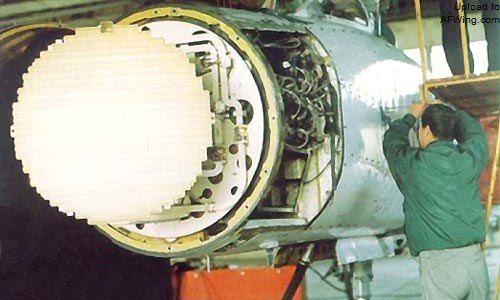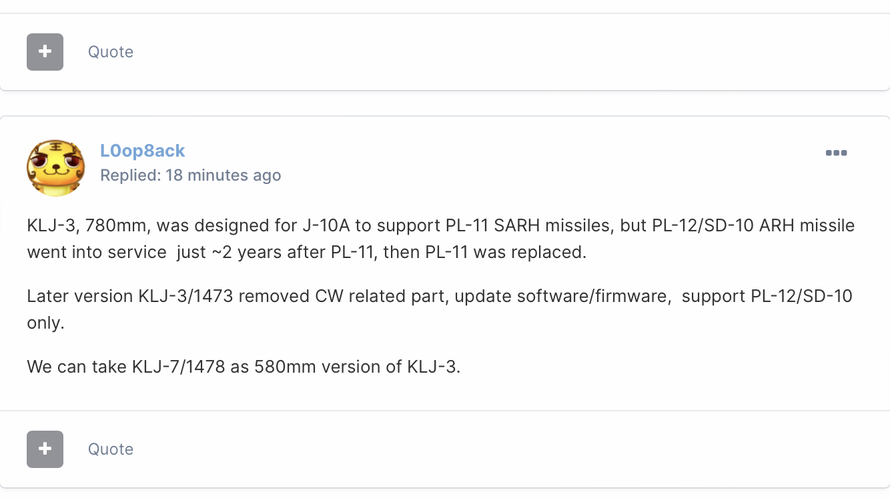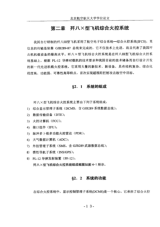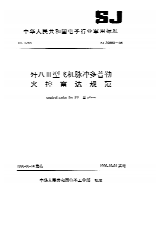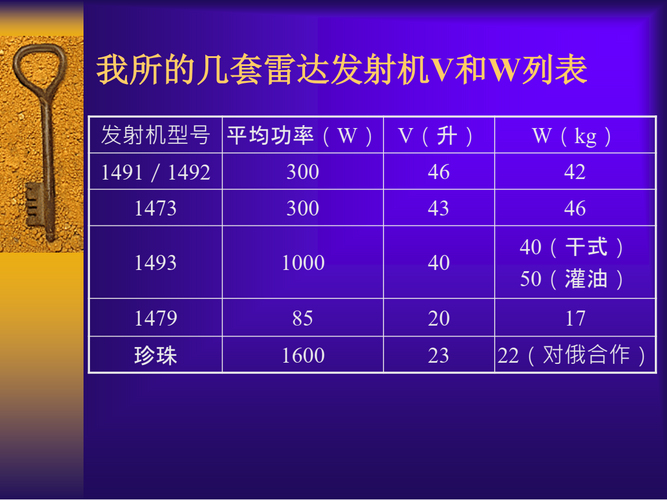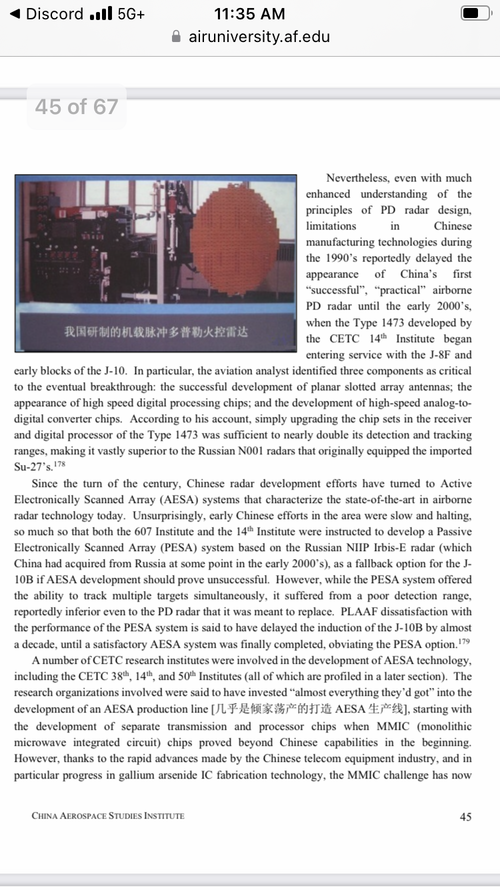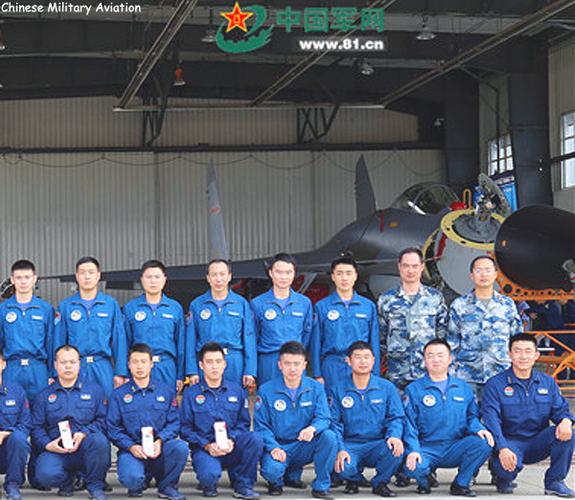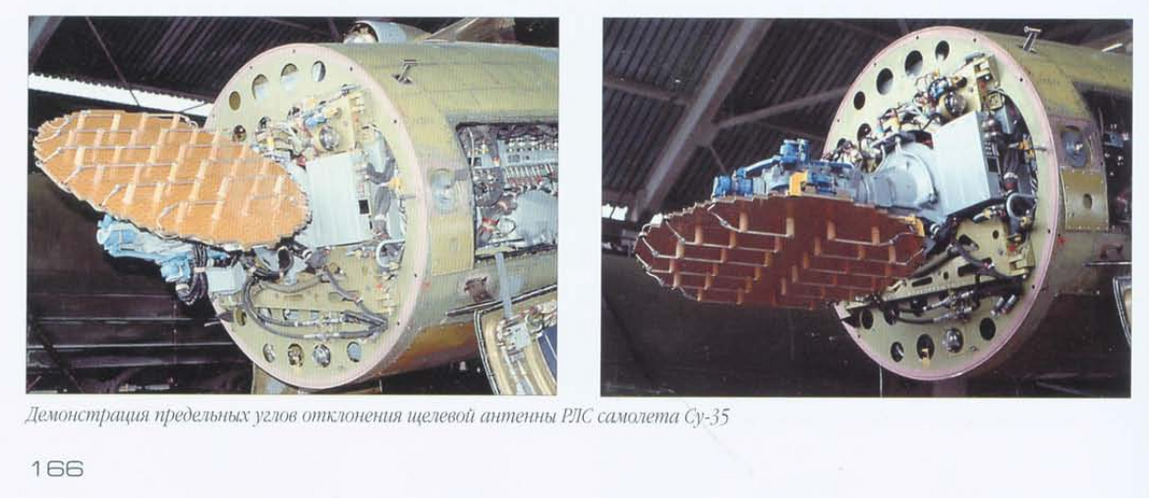Pay attention
Text: Zhu Kexin, Yang Chun
As a professional research institute of airborne radar, the pre-research work of PD radar began in 1973. In 1979, the General Staff and the National Defense Industry Office officially determined that 607 would undertake the PD radar research mission, and made it clear that the mission was aimed at the J-13 aircraft and named it "Engine 802". In the same year, the Jinan Conference of the National Defense Industry Office decided to jointly develop 607 and 782 factories, and it was also determined that 607 would be the chief division unit in the design stage. In June 1982, 607 PD radar ground system prototype 802-I completed an air target test at Sichuan Dazu Airport, verifying the PD system. Later, when 607 demonstrated the new JPD radar scheme, under the guidance of the leadership of the department's hospital (bureau), the scheme was finally fixed at the high starting point of all-waveform all-digital processing and named the "802-II overall scheme", which became the basis for the development of JL-10 PD radar. In July 1983, I was appointed as the chief engineer of the institute. I am well aware of the great responsibility, and I will make greater efforts in fulfilling the "Air Force's instructions". In February 1984, after completing the 204 radar development task, he took over the 802-II engineering task (named JL-10 radar) as the chief designer. However, on March 24, 1986, the Commission of Science, Technology and Industry for National Defense No. 355 decided that 607 would no longer undertake the development of PD radar for fighter jets.
The development of PD radar suddenly stopped, like a thunderbolt, which stunned me. Later, I learned from Minister Mo Wenxiang's speech that there were two reasons for stopping: first, PD radar costs a lot of money, and the country's financial resources are limited, so neither company can do it; second, although 607 has technical advantages, its geographical conditions are not as good as each other. This decision makes me very puzzled: Originally, the PD developed by 607 was explicitly issued by the higher authorities. We worked hard in the third-tier areas and made rapid progress. When we were full of pride to do a great cause for the country, we suddenly stopped it. In the face of giving up halfway, it was not only difficult to give up emotionally, but also 18 With the hard work of 0 engineers and technicians for three years, the result of the national investment of 28 million will be was in wastance, which is more difficult to accept. Nowadays, PD radar is an electronic device that is very important to improve the combat capability of the air force and is blank in China. 607 is not engaged in this research and development, and does not develop from this direction. What is it called a professional research institute of airborne radar? We are a big country. There are many types of air force and navy aircraft, and the demand for advanced radar is large. The research and development force is not more but less. The research and development level is not high, but the gap is too big. The equipment of the army is not advanced but backward. We should use peacetime to lay the foundation and the upper level and rise up to catch up with the international level. Even if the country's economy is not rich, 607's continued development of PD will not cause a heavy burden on the country, because the large amount of money that PD will spend has been spent before, such as instruments, equipment, external devices and materials have been put in place, and the later work is mainly the debugging and testing of the extension and the whole machine. Seeing that the radar was born soon, is it a little unrealistic to say that the country's financial resources are limited? Stop now, it's just a big waste. Why don't you let it come out and let the air force test it before making a long-term plan? Besides, the two companies engaged in PD can introduce a competition mechanism. In the era of market economy, competition is a big trend, which can improve performance, save money, and speed up, which is beneficial to the country and the army. To be fair, speaking of geographical conditions, the ravines with inconvenient transportation and remote villages cannot be compared with large cities with developed transportation, surrounded by universities and industries, but the reality is that both places are engaged in PD radar, and more than half of the process is to decide the selection point. Is it a little out of time? Now I have chosen the point of the big city, and it is not appropriate to let go of the point of the ravine? Let's recall the history. How did the 607 places in the ravine come from? Originally, the scientific and technological strength of 607 institutions was in the big cities (Chengdu and Luoyang). At that time, it was necessary to build the strategic rear of the motherland, "prepare for war", and transfer the national defense scientific research power to the third-tier areas, starting from national security and long-term interests. This is a national action. One mobilization, we people did not hesitate to settle down in the ravine from the big city in 7 days. We have lived a hard life for more than ten years and have been dedicated in obscurity. Now that the reform and opening up have been opened, the units in the valley are no longer suitable for the development of scientific research, so we should consider moving 607 to big cities so that 607 can continue to play a role in scientific research.
Now in this way, in addition to stopping the development of PD radar, there is no way out, which makes people feel that it was wrong to come to the valley at the beginning. Not to mention losing their youth, but also their children. The pain of 607 people is difficult to describe in pen and ink.
In early June 1986, the Ministry of Aviation Industry held the "PD Radar JL-10 Stage Achievement Report and Approval Meeting" in 607, with 55 departments, including the Sixth Bureau of the Commission of Science, Technology and Industry for National Defense, the Fourth Department of the General Staff, the Scientific Research Department of the Air Force Command, the Naval Aviation Research Department, the Sichuan Science and Technology Office, Tsinghua University, and the National Defense University of Science and Technology. Nearly 100 representatives of the unit attended the meeting. At the meeting, I made a report on the "Development of Airborne PD Fire Control Radar JL-10" on behalf of the 607 Institute, in order to let more leading organs and units understand the development capabilities and radar technical characteristics of the 607 Institute. It is more suitable for the requirements of the new air force fighters, and I hope to get the support of the military. In the report, I emphasized the following points:
(1) The importance of PD radar. Generally, when airborne radar detects low-altitude targets, it also receives the echo of strong clutter on the ground while receiving the echo of low-altitude moving targets. If they can't be distinguished, they can't detect low-altitude targets. Therefore, the current airborne radar cannot find low-altitude penetration targets, and the ground radar is not easy to find. Ground anti-aircraft firepower is also not easy to work due to the short reaction time. Therefore, low-altitude penetration has become an important means for invading aircraft to improve their survival probability. The design of the B-1 and Soviet Union's "reverse fire" strategic bombers highlights the penetration ability of low-altitude high subsonic speed. In the early 1960s, there was an enemy aircraft invading at low altitude at night over our border defense. Our all-weather fighter radar could not find the enemy aircraft, so dealing with the low-altitude invasion of enemy aircraft was an urgent problem for China's air defense. Using the principle of the Doppler effect of electromagnetic waves on the echo of moving target, the airborne PD fire control radar uses phase-parallable transmission reception and frequency domain filtering processing technology to distinguish the ground clutter echo from the low-altitude moving target echo, so that the low-altitude moving target can detect the target in the strong clutter background. This is "down vision" Ability. The aircraft is equipped with PD fire control radar, which can deal with low-altitude invading aircraft. The United States was the first country to develop and use airborne PD fire-controlled radar. In the 1970s and later, fighters equipped with troops were equipped with PD fire-controlled radar. Britain, France and Sweden also used this radar earlier. It is now internationally recognized that the equipped with PD fire control radar is an important symbol of modern fighters.
(2) One of the characteristics of PD radar JL-10 is the full waveform (that is, there is a high, medium and low pulse repetition frequency). The Air Force's requirements for the new fighter are "with medium-range all-directional blocking and close-range fighting capabilities, and can shoot down and upside down, and have a certain ability to attack the ground." Only the full-wave PD radar can meet the requirements of the new fighter. At that time, only the JL-10 radar could meet the requirements. High pulse repetition frequency has its advantages and has the ability to look down. The British air combat simulation results show that the results of the head-on attack are several times higher than the tail attack; the high pulse repetition frequency has the maximum down-vision detection distance, so the high pulse repetition frequency is the ideal waveform, which is most suitable for over-the-the-sight medium-range missile head-on. The fighter has a full-wave PD fire control radar, there is The combat ability to meet the enemy around the clock, fight at all altitude, and attack in all directions.
(3) The development of JL-10 radar is progressing smoothly. The special study has fully completed 23 key technologies and 66 topics, formulated the implementation plan of the whole machine, completed the design of the extension and the whole machine, and is carrying out the work of extension processing, extension assembly and extension debugging. It is expected to complete the debugging of the whole machine and the environmental test of the whole machine in 1988. In this process, It is a pity to stop the development.
The minutes of the meeting held that the overall scheme of 607 PD radar is advanced and can perform a variety of different tasks. It has a large degree of digitalization and has achieved 62 scientific research achievements. It has not only broken through the main difficulties of PD radar, but also some systems have developed prototypes that meet the design indicators, especially the sky. Line systems, high-purity frequency synthesizers, antenna servo and stability systems, programmable signal processors and other subsystems, as well as antenna conductive bonding, molten core aluminum alloy waveguide casting and other processes and some special test instruments are in a leading position in China. These achievements will play an important role in China's PD radar research. . After the review meeting, six experts and professors jointly sent a letter to the national leaders, and pleading to take measures so that the scientific research results of 607 institutes can be applied and the team should not be separated.
At the end of December 1987, Deputy Commander Lin Hu of the Air Force and Deputy Chief of Staff Ge Wenjun made a special trip to 607 to inspect. They were very supportive of PD radar and sympathized with 607's situation. The chief said: The PD radar has been found and can test fly at an empty base. This instruction has given us great encouragement. From January 31 to February 2, 1990, Minister Lin Zongtang of the Ministry of Aerospace Industry and 11 people came to 607 special inspection of the development of PD radar. Minister Lin gave a high evaluation of the work of 607 Institute. He gave us a far-sighted way to "speak less and do more, just do more, keep a low of time, lay down and taste the courage, overcome all difficulties, work hard, and use one day as two days." Minister Lin's loud words aroused the enthusiasm for work in the hearts of the employees, and the whole institute began to compete for seconds and solid practical actions to "pay close attention to quality and ensure the success of the PD radar test flight".
In June 1990, the PD radar flight test prototype successfully passed various routine tests and electromagnetic compatibility tests, and was ready for the test flight. On July 18, more than 80 participants headed for Jiuquan, located in the desert, with the expectations of the department leaders and the trust of all the staff. In accordance with the instructions of Deputy Commander Lin Hu, Kongyi Base also sent a special plane to Chengdu to transport radar and instruments. Because the test flight site is far away from the research institute, all the things needed for the test flight are brought with all the four trucks. Personnel, machines, equipment and instruments all arrived at the base on August 4. More than ten tons of machines and instruments and equipment are carried by ourselves, and hundreds of boxes, large and small, are carried by our shoulders. In this way, the day after arriving at the base, the radar was set up. It placed too much hope and enthusiasm. In our hearts, the value of radar is more valuable than gold. When I took someone to check the power supply of the tarmac, I was surprised to find that the three-phase 400Hz power supply at the base was 115V, and our radar used a phase voltage of 115V. I asked the base staff if there were any other three-phase power supplies? Answer: No. Now I'm nervous. The tarmac is our main workplace. Without power supply, it is difficult to walk. After discussion, I went to other stations to ask for help. I pulled Wu Qingyuan, and the staff of the base led the way. I got on the jeep and set off. The Gobi Desert is flat, the ground is sand and small stones, with a piece of yellow color, and there is a dwarf plant called "camel thorn" in sparsely. The car runs fast. There is no need to worry about traffic accidents. If you can't see people, you can't meet cars, and the road is equally flat. My heart was heavy, and I didn't know how far I had gone. I found two stations, that is, two bungalows, but there was still no power supply, and I was even more anxious. The emperor lived up to his heart." Finally, he found it.
The Gobi Desert in August and September is extremely hot. Looking at the heat coming out of the distance, it is really like a blazing flame, which makes people feel that they are by the stove, a dry heat. The baseman said: If you don't wear a straw hat in the sun, you can tan in two or three days. He also said: bury eggs in the sand, and they can be cooked after noon. When you go back to the guest house, it makes you feel like another place, like the cool autumn season, with no sweat on the skin, smooth and cool, and very comfortable. At night, it's like winter, and you have to cover it with a thick quilt. During the flight test, everyone was very busy. The radar should be checked before the flight, and the improvement should be improved after the flight. As soon as the overtime was worked, it was 12 o'clock. Some comrades are unconvinced and get sick, and they can't get a rest. The position needs him, and everyone insists on working with illness. There is no Sunday at work. In October, in order to seize the time, I often work overtime until 3 o'clock in the middle of the night or even later. It's better to work in the plane. Those comrades who take turns to monitor the baby's power supply beside the plane are miserable. They can only wear leather coats and stay there against the cold air.
In early October, Minister Lin went to the base to visit everyone to check the test flight. After carefully looking at the test flight data, he called the three leaders to the car and said, "The Air Force supports us in the test flight. It's a rare opportunity. The conditions here are good. We must fly the radar out." There is still a little less data in two states. It is better to make up one or two ups and downs, especially to fly well in the high pulse repeat frequency state. For dinner, the minister met with everyone in the canteen and encouraged everyone to make persistent efforts to fly out the radar. The minister also said, "The transfer of 607 is to increase the PD radar. If you don't engage in PD radar, there is no need to transfer." The minister's words inspire everyone to fly the PD radar with greater determination, which is a major event about the future and destiny of 607. The head of the base set up a dinner party to entertain Minister Lin and his entourage, and I was invited to accompany him. Minister Lin introduced the PD radar to the leaders of the base. It was developed under very difficult circumstances and is very important to the Ministry of Aerospace Industry and the Air Force. I hope the leaders of the base will strongly support it.
The test flight was first made on August 30 and ended on October 26. It lasted 56 days, with a total of 22 batches of 45 flights. The test flight was a complete success. The summary of the PD radar scientific research test flight technology jointly written by Air First Base and the First Air Force Research Institute has the following conclusions:
(1) The all-phase parameter PD system used by the radar has been actually verified. It is a real airborne PD radar. It has the ability to filter the target echo pulse string signal spectrum and detect low-altitude targets with a certain speed movement in the background of terrestrial clutter. The radar uses three repeat frequency waveforms (i.e. full waveform) of high, medium and low, which has been proved successful by test flight.
(2) The 607 Institute of the Ministry of Aeronautics and Astronautics and Astronautics broke through the airborne PD technology and developed China's first full-wave airborne PD fire control radar (principle prototype), which is mainly reflected in the following technical breakthroughs: 1 It broke through the "three high" technology of airborne PD radar and developed high gain and low sub-valve. Plate seam array antenna; high-purity spectrum RF signal generation and amplification device and high-speed digital signal/data processor, and successfully applied to the principle prototype. 2 Break through the Buck code pulse pressure and PD compatibility and high pulse repeat frequency distance gate selection distance (HPRF RG) technology, thus successfully designed the full-waveform airborne PD radar with a domestic low peak power single-mode wave tube. 3 Break through other key technologies necessary for airborne PD radar, mainly including main clutter tracking technology, all-digital main and secondary valve clutter suppression technology, distance and speed two-dimensional fuzzy technology, and time-se segmentation dual-channel single-pulse angle measurement technology. Compact structure design.
This is the crystallization of the joint struggle between 607 and dozens of brother units. After the successful test flight, in order to record the hard journey of the participants and promote the spirit of the team, 607 produced a documentary. Minister Lin happily named the documentary and wrote 9 "a shocking triumphant song" Big characters.
In order to report to the central chief and the leadership of the air navy, the Airborne Equipment Corporation of the Ministry of Aeronautics and Astronautics Industry held a report exhibition on the development results of PD radar and aeroelectric integrated system in Beijing on December 3, 1990. After the meeting, Minister Lin invited guests to have a discussion. Everyone said that after watching the display of the two prototypes, they were very excited and excited. They expressed their appreciation and congratulations on the achievements. Director Chen Bin believes that foreign countries cannot rely on the lessons of history and reality. We should unswervingly implement the policy of self-reliance. 607 All stocks are valuable self-reliance spirit. Deputy Commander Li Jing said that the results are not simple. If you work hard and work hard, you will do a good job and get it out. Wang Ang, Vice Minister of the Ministry of Aeronautics and Astronautics Industry, said that 607 has a good understanding of the characteristics of airborne radar, and PD radar has taken a key step. As long as it is supported by its superiors, it is very promising to be developed. Deputy Commander Li Jing also said that I support Minister Lin for everything on the plane.
However, the test flight was successful, and the radar did not usher in a bright future, and 607 was in trouble for the second time. Where is the road? What is the future? Once again, I am concerned about the heart of the leading organs of the ministry. On January 20, 1991, Minister Lin delivered a speech at the working meeting of the Ministry's airborne Equipment Corporation, expressing the new arrangement of the department's leaders for PD radar. He said: "607 is in the valley, the conditions are difficult, but they carry forward the spirit of self-reliance and hard work, with little money and not long time. The development of our department is also the first full-wave PD radar in our country. After the test flight, it was unexpectedly good. The target was found at 80 km, which was very gratifying. Therefore, we must continue this work. The results cannot be lost. 607 schools still have to work hard, sleep on firewood, and strive to make PD radar better. After the meeting, Minister Lin specially asked Vice President Liu of China Aviation Technology Import and Export Corporation (hereinafter referred to as China Aviation Technology) and instructed him to "coer with GEC to use PD radar for military export aircraft, and can also be used in China if necessary." Director Xu of 607 attended the meeting. After returning to the meeting, he conveyed the spirit of the leader's speech. For the first time, I heard that the minister arranged for this type of radar for military trade export aircraft. I have thought over and over again that the way I expected did not work. In this extremely difficult situation, it is indeed a good strategy. As the Ministry of Aerospace Industry, it is right to master this advanced technology to ensure the development of aviation equipment. As a professional research institute of airborne radar, there is no way out without tracking this high-tech and developing PD radar. Now that the ministry has made up its mind, I fully agree and am determined to go on firmly. The institute soon prepared a preliminary idea of a new PD radar. In early February, Hu Tingyi and I went to Beijing to report to the Ministry with this idea. Zhang Rumou, Director of the Planning Department, Yang Yansheng, General Manager of the Aircraft Equipment Corporation, Deputy General Manager of Yan Zhixiao, Jin Dekun, Director Yang Tanfu and Director Wang Naifang, etc., listened to the report. I reported the main points of the preliminary vision of the new PD radar:
(1) The installed target is the military trade export aircraft, that is, the J-8II export type or super 7 aircraft; (2) Domestic research and development, strive for international cooperation; (3) Add functions, improve performance, cross-link with CWI, guide A bullets, miniaturization (this is the key), improve reliability and Maintenance; (4) Three machines are developed, and it takes three and a half years for domestic research and development. If international cooperation is advanced, it can be advanced to two and a half years; (5) The funds are considered according to domestic research and development, with a total investment of 50 million yuan.
Everyone agreed to invest funds in this plate, but felt that the funds were a little tight. Director Zhang said that in addition to the financing of the planning department and the airborne equipment head office, 607 should also raise some by themselves. Finally, it was agreed that the development cycle was 3 years. On January 20, 1991, after Minister Lin's speech, he began to build a new PD radar model team. Due to the change of the situation, first, the national task has not been obtained. Now the task is arranged within the department, and the export aircraft has not been determined. The Commission of Science, Technology and Industry for National Defense does not support it. There is less investment and more difficulties. Second, the relocation of the PD technical team to Wuxi has been decided, and PD is developing in Wuxi. The technical personnel have such a thing. Specific considerations. Therefore, after repeated communication and combination, the technical leader of the new model (JL-10 A radar C-type) was finally determined to be:
Chief Designer: Zhu Guiling Deputy Chief Designer: Dai Yingyun Li Tianxing Some original technicians did not want to go out of Sichuan, but they were still willing to do PD work, so they agreed to work in Neijiang PD, which is called "working in different places".
In March 1991, the Ministry's Planning Department submitted the "Request for Instructions on the Continued Development of PD Radar" to the Ministry's Party Group, which was quickly approved and approved by the Ministry's Party Group. Since then, the development task of PD radar engineering prototype for the export of military aircraft foreign trade has officially started. In order to discuss the improvement of JL-10 radar and determine the PD radar plan for export aircraft, in early April, I went to the 132 factory with relevant personnel to investigate the radar selection considerations of the super 7 aircraft. In late April, I went to the 112 factory to investigate the consideration of radar selection for the J-8II export aircraft.
I met Minister Lin at the 112 factory, and he asked me to have breakfast with him. I reported to him the investigation of the two places. He said that he had previously said hello to Tang Qiansan, the general manager of the 112 factory, Xie Sishi, the director of the 601 institute, Li Ming, the chief designer, and other leaders. It means that the department supports 607 PDs to continue. If you want to install the J-8II export model, you want to ask them to support it. They all agreed. Minister Lin encouraged us that we must do a good job in PD, and the distance, miniaturization and reliability must be done, which is related to the major events of 607 and the Ministry of Aerospace Industry. I also believe you can do it well. I deeply feel that the leaders of the department attach great importance to PD radar. He has paved the way for us in advance of my research, and also lamented that the work in the department is really in-depth and meticulous.
During the preliminary preparation period, after two plans were discussed within the model line, and in early May, everyone unified the two-step approach. First, for the J-8II export model, the volume is 0. 138m3 and the weight is 150kg. The second step is to further miniaturize the radar for the Super 7. The plan is determined here. From May 18 to 19, 1991, the Ministry of Aerospace Industry held the "Military Trade Aircraft Fire Control Radar Scheme Demonstration Meeting" in Wuxi, which attended the meeting with a total of 70 representatives of leaders, professors and experts from 25 units, including the State Planning Commission, universities, research institutes, aircraft companies and ministerial organs. 607 leaders Xu Tiren, Zhu Kexin, Li Dechun, Yang Chun, and 27 people, including the head of model technology, Zhu Guiling and Li Tianxing, attended the meeting. The meeting was presided over by Zhang Rumou of the Planning Department of the Ministry. Minister Lin attended the meeting from beginning to end. At the opening ceremony, Minister Lin pointed out in his speech: "From the perspective of the past Gulf War, we should highlight the status of aerial power and the important position of PD radar. The military trade aircraft radar is captured by the Ministry as an important project. The radar should be smaller, lighter, full of functions, and more distant and reliable. The sex is higher, the maintenance is better, the price is cheaper, and the time is only 3 to 4 years. It is necessary to give full play to the joint advantages of the two major systems of aerospace and carry forward the industry spirit. Experts at the meeting have rich experience and should make more opinions. 607 should be modest. If you have heard it, you will be happy and learn from others.
Zhu Guiling, the chief designer of 607 PD radars, reported the basic plan of the fire control radar of the military trade aircraft. Minister Lin is most concerned about the detection distance, miniaturization and reliability of PD radar. In the evening, experts and professors discussed these three questions. When discussing the detection distance, I first talked about the distance data tested by JL-10 on the Air One Base An-24 aircraft. In order to improve the detection distance, there are four ways in JL-10 A:
(1) During the test flight of the JL-10 of the An-24 aircraft, two long waveguides were installed, which will not be available in the future and can reduce loss; (2) Improve the noise coefficient of the receiving system; (3) Double the accumulation of FFT of the information processor; (4) The antenna caliber from 600 The mm is increased to 700 mm (I roughly calculated the value that can be improved), and experts believe that the action distance is feasible.
At the closing ceremony, Minister Lin made a concluding speech. He said, "The biggest revelation given to us by the Gulf War is to make up our mind to establish an air defense system that integrates heaven, space, earth, sea and electronic defense with active defense. For aviation, the most important thing is fighter jets. In addition to the mainframe, the turbofan engine and PD radar (including the electronic integrated system) are two highlights and two weak links. According to the research of the Party Group of the Ministry, one mainframe and two focuses should be grasped as the strategic guiding ideology of the aviation industry in the 1990s. American fighters are equipped with a variety of full-wave PD radars, all of which have the functions of down-down shooting, head-to-head blocking and so our fighters must make the greatest determination to install PD radar with good performance, with the combat capability of over-the-horizon. Minister Lin continued: "Many comrades suggested that this radar project should be named 'Eagle Project'. Why? Because the eagle flies very high, has the ability to see far, and can distinguish and track the target. Once the target is found, it will track accurately until it is caught. If everyone agrees, it is suggested to submit it to the party group of the Ministry for approval and then officially name it. In order to strengthen the leadership of the development of PD radar, whether to establish an organization in the Ministry will lead the radar project. It is also suggested that, like other major projects, set up a system of chief commander-in-chief and chief designer of the administrative site. This needs to be discussed with the relevant departments, but two people can decide now: the chief commander-in-chief of the administrative site is held by Director Xu, and the chief designer is chief engineer Zhu.
Finally, the minister made a request: "First, we should carry forward the industry spirit of self-reliance, hard work, strong coordination and selfless dedication, and carry forward the spirit of two bombs; second, we should do a good job in great cooperation, first give full play to the joint advantages of the two systems of aerospace, and the whole Ministry of Aerospace Industry should give the green light. There were different opinions on the PD in the past. I reported to many national leaders until the General Secretary, and they agreed with me. Later, I paid a New Year call to Vice Chairman Liu Huaqing and reported this matter. He also agreed, so comrades should not have any concerns. Let go of your hands and feet. It's everyone who has the credit. If there is a problem, I will bear it. More than 20 people, including 607 PD model supervisors and deputy supervisors, attended the closing meeting. The minister's speech greatly encouraged everyone's enthusiasm for work, and everyone was determined to make PD up.
In early June 1991, the Ministry of Aeronautics and Astronautics established the "Shenying Project" General Command and the "Shenying Project" Office. Its composition is: Chief Commander: Zhang Yanzhong Executive Deputy Commander: Zhang Rumou Yang Yansheng Deputy Commander: Jin Dekun He Yijin Lu Huimin Chi Yaozong Liu Guomin Zhang Hongxian Director of Office: Jin Dekun Deputy Director: Wang Naifang, Huo Jinming, Shi Ning
The personnel transferred from Neijiang to Wuxi are basically in place and are preparing for the temporary laboratory. On the evening of April 22, 1992, Minister Lin, Zhang Rumou and Yang Yansheng, who held a meeting in Shanghai, took time to come to Wuxi. That night, Minister Lin said to me, "I think the transfer work is relatively smooth. Now it seems that this step is the right. At that time, I felt very difficult, and I was a little shaken. Now I see new hope. I have to work hard on the PD. He also said to me, "We should hurry up to cooperate with Russia. When they wake up, it will be difficult. Hold them back, buy them if they can, and buy components, so as to buy time and reduce risks." The next morning, Minister Lin and his entourage visited all the staff in front of the simple dormitory and spoke, encouraging everyone to work hard, overcome the current difficulties, and put up the PD radar. The leaders of the department are very concerned about the relocation of 607. After Minister Lin took office, he accelerated the transfer process in order to get the PD radar up as soon as possible. When the PD test flight was successful, Minister Lin received all the leaders of 607 in Beijing and instructed us to go to Wuxi as soon as possible and relocate as soon as possible. On April 1, 1991, Minister Lin handed over the letter signed by himself to Chen Huanyou, Governor of Jiangsu Province, during his participation in the National People's Congress. After returning to Nanjing, Governor Chen issued an instruction on April 12: Wuxi Municipal Government is requested to handle it according to the requirements of Minister Lin's letter.
This relocation has solved the worries of my middle-aged technicians, changed the dilemma of my lack of successors, and solved the survival problem of 607. The department has created good development conditions for us, and we cherish it. At night, the experimental building is often brightly lit. Everyone is working overtime, and they also work overtime on weekends. Even if there are 8 days of the Spring Festival, there are 4 shifts, which is common. Minister Lin asked us to "super two days as three days, and seize time from the quality". We are used to intense work, because we see the dawn and hope ahead. Since the establishment of the headquarters, the headquarters and its offices have been busy. The implementation of the PD plan, the collaborative projects with the Aerospace Academy and the Ministry of Electronics, the coordination of interfaces with aircraft, the review of the implementation plans, the work inspection of the planned nodes, and even the preparation for flight test have all been personally arranged by the headquarters. , called for implementation. After three busy years, the radar has been developed, and the next step is to prepare for the test flight.
607 test flight leading groups have been set up. The team leader is Xu Tyren, and the deputy team leader is Zhu Kexin (chief designer), Bao Decong, Zhu Guiling deputy (chief designer). The members are Li Tianxing, Zhang Kunhui, Xia Yihua and Hu Tingyi. After entering the China Flight Test Research Institute (referred to as the Flight Test Institute, or 603), I detailed the division of work and clarified the "responsible person for the air test organization", "responsible person for radar technology guarantee", "responsible for technical management", "responsible for administrative management", "responsible person for flight planning coordination", "Test flight data admission and collation responsible person" and other 6 aspects of personnel. So that everyone has something to do, and everyone has something to do.
The test flight test institute has set up a leading group, which is composed of: Team Leader: Chen Qishun (President) Deputy Team Leader: Zhang Kerong (Vice President) Huang Bingxin (Vice President, Head of the Air Force Test Fly Test Group) Head of Flight Test Technology: Wu Guoliang (Deputy Chief Division) Head of Test Flight Air Service: Li Yumin (Air Force Test Flight Test Deputy Chief of Staff of the Regiment) The test flight institute is generally a test flight of various newly developed aircraft, and the test flight radar is the first time. Because it is a professional test flight institute, the work is easy to work, and the efficiency is very high. It only takes 40 days to get everything ready.
After entering the test flight stage, we are still very busy, because (1) the PD radar is basically adjusted and entered the test flight hospital. The software and interface of the data processor and information processor, as well as further improvement, we have no time to do it, so we have to use the test flight gap to do it quickly; (2) Check the thunder before the test flight. Da, ensure that it is in good condition. If there is a problem after the test flight and landing, it needs to be studied, and it needs to be improved after the cause is identified; (3) Some work can only be gradually adjusted through flight tests, and the ground is difficult to simulate, such as digital automatic gain, constant virtual alarm, map mapping, beam sharpening, main clutter tracking, etc. I always feel that time is tight. The work arrangement of entering the site every day, or the promotion, or the mobilization of things, can only be told on the special traffic vehicle for the entrance.
Since mid-March 1995, several consecutive flight tests have had the same phenomenon: if the target is found, the target can also be intercepted, but it can't keep up with the target, and in the ground inspection test, passive tracking is always normal. First of all, I thought there was something wrong with the data processor software, but I didn't find anything after checking it. Some modifications have been made to the interception instructions and fuzzy procedures, and the situation has not changed after the air test flight. I checked the microwave and front-end circuit plug-in damage, and no problem was found. At that time, Li Tianxing and Zhang Kunhui and I were anxious and a little helpless. I was under a lot of pressure, and several people talked about it: If I can't pass and withdraw to the institute, I'm afraid it will be difficult to fly again, and the consequences will be serious! I think we should continue to work hard and not be defeated. On April 10, Mr. Zhang and Director Yang came to the test hospital to inspect the work. Director Yang asked me, "Do you want to invite experts for a consultation?" I said, "I haven't found the problem now. Please come and it may not help." I discussed with my colleagues that the difference between the ground and the sky is that there is no developed an injector, so we need to develop an injector to check it. In this way, it is necessary to open the aircraft engine to provide power on the plane, which is not a small thing. After we contacted Mr. Wu and Yang Xinsheng of the test flight institute, they were very supportive. The next day, the engine was turned on and the injector was also developed for tracking test, but no problem was found, and tracking was still normal. In the past two days, everyone has been restless. Usually, comrades see that I am old and advise me not to get on the plane for the test. Now, I really want to get on the plane to have a look.
On April 21, the afternoon flight two-aircraft test was arranged. The subject is "LM on-view tail tracking, MAP". In the afternoon, I got on the plane and sat next to Cao Zhenglin and Wu Liangbin. In front of the radar display, when the two planes were still climbing high and the two planes were still close to each other, I made an exception to let the radar turn on and work and saw the target, which was normal. I also let the radar intercept the target, and then I stared intently. To display the picture, you can see every small change clearly. You can see the circle and point of the target, but the circle and point move to the west, and then the antenna turns into the detection state, and then intercepts it to see the change repeatedly. It is still the same. It shows that the movement of circles and dots is regular, not random. I initially think that there is a signal of the pitch difference after interception, and there is no signal of angit difference. At this time, the dual machine has reached the planned test height, and the dual machine has also opened the distance and started the original test. After two interception tests, what I saw was still the same, so I gave up. Then do MAP, which is normal. On the way back, we discussed it on the plane. I talked about my opinion and thought that it was not that the radar adjustment was not in place, but a fault. A comrade asked me where the fault is? I said it might be on the angential difference channel from microwave to the front end. Some comrades don't believe it. I said I could check it. They said it was difficult to check. I said that the signal power can be sent from the angential microwave coupling, and the angistent front output is connected to the spectrum tester to observe the changes before and after the emission.
At this time, Cao Zhenglin stood up and said that he could try it. In this way, I connected the cable, Xiao Cao adjusted the instrument, and the other comrades got off the plane and waited by the plane. The two of us checked that the connection was correct, so we developed the shooting machine. At this time, my heart beat very hard. After all, it was just an analysis, and it was the final inspection. As soon as 3 minutes arrived, Xiao Cao first saw the pointer of the spectrometer fall down. He jumped up and shouted, "Ah!" The comrades who got off the plane thought that something had happened on the plane, so they quickly got on the plane and looked at it. It turned out that the problem had been found. Everyone was very happy, and the problem that had been bothered everyone for more than a month was solved.
After the radar inspection was repaired, the flight test was conducted on April 25. The weather was cloudy, and the subject was unfinished on the last flight, that is, "LM upper vision tail tracking". In the experiment, the target tracking is very stable and normal. Looking at the MAP, when I saw the Yellow River, it showed that the root was found last time and completely solved.
On May 9, the weather was sunny to cloudy, and a flight test was planned in the afternoon. The subject was "M-down vision tail pull tracking". At 15:31, the plane took off; at 15:54, the test began. The downward tail pull tracking has been done successfully. The first tail pull has been completed, and I am ready to do it for the second time. At this moment, the plane was obviously bumpy and unstable. Suddenly, the plane fell down at an altitude of 4100 m for a few seconds. The human feeling first seemed to be hanging in mid-air, and then threw it down heavily. The radar on the plane is fixed, and some instruments are placed on the stage with only baffles to prevent them from sliding down. There was a signal source instrument weighing 35kg, which was thrown into the air and then smashed down. A colleague, when the plane fell off its height, his head touched the iron frame on the plane's ceiling, and a big bag bulged on his head. Then the plane was still very bumpy and could not sit still. The sudden disturbance made our testers in the cabin panic, and I don't know what happened. At this time, Cao Zhenglin and Wu Liangbin turned off the radar. I realized that this was a vertical airflow disturbance, also known as wind shear. We were in the air this time. Fortunately, if it appeared during takeoff or landing, it would be amazing. I looked at those young people. They seemed to be uncomfortable. Some were lying on the desk, and some were sitting with their eyes closed. I was worried that I would encounter the airflow again, and I also felt frightened. I was uneasy, and I couldn't do the experiment. At this time, the plane was calmer. I walked to the cockpit door and suggested that the captain return. When the plane landed, everyone could get off the plane by themselves and walk out of the hatch. They were still pale and tired. These comrades are the supervisor designers who often go to the plane test. I should have taken care of them to have a good rest at night, but for tomorrow's flight test, I was really reluctant to inform them to work overtime at night. They agreed and listened to the arrangement. They didn't have a good dinner, so they got on the bus and worked overtime together. It really moved me! Our science and technology team is trained from the third-tier and difficult areas. We can always take into account the overall situation, not afraid of hardship and fatigue, and work hard for the radar cause.
The test flight No. 7 (No. 72) flew 28 times, and the test flight mission was successfully completed. There were only two tests that were invalid due to damage to radar components, and the success rate of the test flight exceeded 90%. Participating equipment such as bus, atmospheric machine, inertial guidance, aviation power supply, wind source, etc. have been working normally. The radar and test equipment are in good condition, which is an important condition for the successful completion of the test flight.
The whole test flight work, from the aspects of planning and design, organization and dispatching, aircraft support, air-to-air command, ground guidance, data processing, etc., is full of the sweat of the leaders, troops and employees of the test flight test team, which is an important guarantee for the successful completion of the test flight. I remember that shortly after entering the venue, Vice President Zhang Kerong said to me, "It's the first time to fly a radar here, and it's also the first time to set up a leading group for the radar test and the president to be the team leader." He also said: "We have made three provisions: (1) As long as there is an urgent need, in case of emergency, it can be handled directly without asking for instructions; (2) The need for test flight, under the principle of no waste, can be regardless of cost; (3) The handling of test flight matters by the organ shall not exceed 24 hours. These regulations are also the first time. It can be seen that the pilot flight test institute attaches great importance and support. I am very grateful and think that only flying the radar well is the best reward for them.
On June 6, 1995, the General Command of China held the "'Eagle' Radar (JL-10A) Test Flight Work Summary Conference" in the Test Flight Institute, which was attended by leaders of higher authorities and sister units, attended by Zhang Yanzhong, presided over by Yang Yansheng, and the leaders of the Ministry, the Test Institute, the Test Fly Group, 60 7 units participated. The test flight institute made the "Shenying Project" radar test flight technical report and the "Shenying Project" radar test flight work summary, and I made the "Shenying Project" radar scientific research test flight work summary at the meeting, and the leading authorities spoke. Xu Tiren, director of the 607 institute, delivered a speech at the meeting. He expressed his heartfelt thanks to the strong support of the higher authorities and units, and the leaders of the test flight corps for their personal leadership, organization and the hard work of the staff, and said that they would continue to work hard and improve. The test flight institute concluded in the "Test Flight Technical Report": The test flight results show that the radar has design functions, and its performance meets or is close to the design indicators. The radar is rarely scrapped due to component damage, and the reliability is good. In the Summary of Scientific Research Flight Work, I especially emphasized that in order to adapt to the installed environment and tactical technical requirements of the fighter aircraft, JL-10 A has made great improvements on the basis of JL-10. First, it has added functions. CWI cross-linking work can hit A bullets; there is GM for selecting the surface of the ground sea. Marking and navigation; TWS can track multiple targets at the same time; DBS can improve the map resolution to attack the precise positioning of the ground and the sea. Second, it improves performance. Third, the volume has been reduced by half. Fourth, improve reliability. In his last speech, Mr. Zhang said, "I am quite satisfied with the results of the radar test flight, and the work is innovative. The functions of TWS and DBS are realized on the PD radar. It is the first time in China that I can cooperate with the aircraft to hit A bullets." Speaking of the researchers of 607 institutions, he said, "This team is an innovative team that can fight hard."
After the summary meeting of the test flight work, the General Headquarters Office wrote a report on the success of the test flight of the "Shenying" radar developed by China, which was published in the briefing on the Major Situations of the Aviation Industry. ** After reading it, the Prime Minister made instructions on the briefing, and the instructions were transferred to Zhu Yuli, the general manager of China Airlines. At noon on July 18, 1995, former Minister Lin called me in Beijing. He happily conveyed the content of Premier Li's instructions and said, "You have done a big thing. It's very good!" Of course, there are still things that need to be improved, which can be improved in the future. Congratulations on the successful test flight of the 'Shenying' radar. Greetings to all the comrades!" I was very encouraged after answering the phone, and I couldn't calm down.
After Minister Lin left office, Air China always supported our work. Deputy General Manager Zhang Yanzhong continued to shoulder the heavy responsibility of the headquarters and led the development of PD radar. In the second half of Premier Li's approval, that is, on July 28, Zhang Yanzhong led the leaders of Han Kuanqing, Shichuan, Zhu Rongzhang, Guo Lihua, Yang Yansheng, Liu Xianglin, Wang Naifang, Chen Huaiqiu, Li Zican and other authorities, as well as Director Xu of 607 and me, a total of 12 people, reported to the leaders of the Commission of Science, Technology and Industry for National Defense on the "Shenying" radar test flight. Besides. Three deputy directors, Huai Guomo, Zhang Xuedong and Wang Tongye, Chen Dazhi, Minister of the Planning Department, Jiang Laigen of the Ministry of Science and Technology, Xu Burong, Deputy Director of the Fourth Bureau of the Ministry of Science and Technology, Liu Sheng, Deputy Director of the Sixth Bureau, Zhang Yao, member of the Science and Technology Committee, etc. Mr. Zhang reported the development process, radar characteristics and test flight results of the Condor radar. Then reporting on the next step, he said: "In order to make the radar form combat effectiveness as soon as possible, AVIC is ready to lead the test flight on an aircraft. In view of the full waveform, multi-target tracking, beam sharpening and other functions, scientific research test flight has been carried out. At the same time, it is compatible with A bullet and P-27 bullet guidance capability, so it only needs to increase the antenna port. After the diameter and the beam sharpening ratio are improved, the requirements of an aircraft can be met. It is recommended to include it in the aircraft improvement plan. After the report, the leaders of the Commission of Science, Technology and Industry for National Defense spoke, and the spirit of the speech was basically the same.
This report has gained a lot. The speech of the leaders of the Commission of Science, Technology and Industry for National Defense obviously conveyed three messages, and also expressed the position of the General Manager of AVIC: (1) Recognizing that the General Manager of AVIC is engaged in PD radar, rather than the so-called "black account"; (2) affirming that the PD radar is doing well, and also properly evaluating the current level of PD radar; (3) The PD radar of AVIC is allowed to participate in the fair competition of military aircraft in China, and the National Defense Commission of Science, Technology and Industry supports the election. In a word, the leaders of the Commission of Science, Technology and Industry for National Defense still care about the PD radar of Air China, which is different from five years ago. We should raise our heads, lighten our strength, and make every effort to strive for a better future.
When the PD radar JL-10 A was still in the test flight on the Yun 7 plane, and it was still in a difficult period. On April 10, 1995, General Manager Zhang and Director Yang of AVIC came to the test flight institute for inspection. At that time, it was considered that after the radar finished the scientific research test flight on the Yun 7 plane, they should also create conditions for the small aircraft. Take a leading test flight. After listening to the test flight test report of the JL-10 A, Mr. Zhang said: "After the radar test flight on the 7 is carried out on the operation 7, it should also conduct a leading test flight on a small aircraft, or a verification test flight, so that the radar is closer to practical and closer to the engineering prototype. I originally wanted to prepare for the zero batch 0 of the J-8II. The plane No. 04 is flying. At present, the plane is carrying a radar for test flight, and it can't be finished for a while, while the JL-10 A test flight will end in two months. I would like to ask for your opinions to see what aircraft can test fly next? As soon as Mr. Zhang's voice fell, Zhang Kerong, vice president of the test flight hospital and in charge of the test flight work, proposed, "You can test fly on aircraft A. We have two aircraft in the test flight hospital, one 85 and 83. At present, there is no task yet." Director Yang said, "I think it's okay. The aircraft has a test flight yard and 607 radars. The supporting equipment for other test flights on the plane is under our bureau's control. We can provide it so that everyone can carry it." Mr. Zhang thought, "This is feasible. 603 will design and coordinate, and then make some funds in the department, and this matter can be done in the department." Vice President Zhang also said, "We can not care about the cost." In the evening, Mr. Zhang asked Li Hongyi, the director of the 603 institute, to talk about this matter, and Director Li was very supportive.
On the afternoon of June 6, after the test flight summary meeting, Mr. Zhang specially convened the on-site office meeting of JL-10 A to verify the test flight on the A plane. The organic carrier bureau, the science and technology bureau, the finance bureau, the planning bureau, the test flight bureau, the military aircraft bureau, the western flying company, the test flight institute, 603, 607 hospitals and other related negatives. Responsible comrades, for comments, for the next step of JL-10 A test flight on A, everyone agreed. Mr. Zhang finally said: "The test flight on the A machine is an adaptive verification test flight, and it is also a leading test flight, creating conditions for the competition for the improved mission of the A machine. This time, the improved fire control system will only fly the radar, aircraft and radar will be changed as little as possible, requiring all units to contribute, careful calculation, and cost-saving. "." This decision is very timely. The military is considering the selection of the improved radar on the A machine, and is also happy to see the performance of the radar on the A machine.
After the General Manager of Air China determined that the JL-10 A radar was used for adaptive verification test flight on the A aircraft, on June 23, 1995, the leading group of 607 test flights held a meeting to study the improvements that the radar must be made. Zhu Kexin, Zhu Guiling, Zhang Kunhui, Xia Yihua, Liao Yifu, Lu Yongxiu, Tang Zhi'an, etc. Participants in the meeting. After discussion, it was agreed that the purpose of the test flight was to verify the adaptability in several aspects: (1) structural installation, aircraft environmental conditions, adaptability of on-board energy supply; (2) radar and aeronautical equipment Adaptability of cross-linking work, radar operation and control, air detection, and ground maintenance; (3) Adaptation of aircraft to the basic state and performance of radar. Radar changes should revolve around this purpose. The change of radar is still very large, and the difficulty can be imagined: (1) On the circuit, solve the remaining problems of test flight on Operation 7; HM repeated frequency waveform improvement; I/Q APC improvement. ( 2) Increase the working status of ACM, AGR and BIT, and change DBS from 8:1 to 32:1. ( 3) Add equipment, including DCMP display control management processor (called aerto-one controller), two cockpit displays, and preparation of hydraulic servo antenna. ( 4) Because the radar is installed on the left and right sides of the aircraft to be installed unilaterally on the right side, the structure is redesigned. ( 5) According to the requirements of the environmental conditions of machine A, the extension should be tested, and the whole machine should be tested for high temperature, low temperature, high-altitude simulation and vibration impact test. On July 4, when Liu Xianglin, deputy director of the airborne bureau and Wang Naifang, deputy director of the airborne bureau came to inspect the radar work, they clarified the coordination of the test equipment.
On September 13, 1995, the model technical leader (JL-10 A radar S-type prototype) was determined to be: Chief Designer: Zhu Guiling Deputy Chief Designer: Zhang Kunhui Xia Yihua Cao Zhenglin Tang Zhian On February 13, 1996, Air China General established the "Shenying" radar test flight. The list of the leading group is as follows: Team leader: Chen Qishun (President of the Test Flying Institute) Deputy Team Leader: Zhu Kexin (Vice Director of 607) Members: Zhu Guiling (Vice Chief Engineer of 607) Shi Xuexin (Deputy Chief Engineer of Xifei Company) Xu Jiashan (Deputy Director of 603) Zhang Quanfu (Vice President of the Test Flying Institute) Designer)
On July 16, 1996, 607 test flight leading groups were established: Team Leader: Xu Tiren, Deputy Team Leader: Zhu Kexin, Bao Dicong, Zhu Guiling, Members: Zhang Kunhui, Xia Yihua, Cao Zhenglin, Tang Zhi'an, Liu Xintan
In the development of radar, its functions and performance should be verified, improved and improved through air test flights. The commanders and pilots of the Air Force Test Mission undertake this mission. They have contributed to the Condor radar with their own wisdom and courage, which makes us admire. On the afternoon of May 8, 1997, the target pilot had to fly another plane first, so he had to wait, all in order not to let go of a good weather. Huang Bingxin, the pilot of the pilot, the head of the test flight regiment and the vice president of the test flight hospital, waited patiently and took off at 18:38. He turned on the force and rushed into the air. Everyone is waiting for him on the tarmac. The sun is about to go down. We keep looking at our watches. Why don't we come back? Everyone was so anxious that they sweated for the commander of Huang. Hearing the sound, the two planes came back. It was 19:27 when they landed, and it was only 3 minutes away from the local sunset at 19:30. It was so dangerous! He got off the plane and we met him. Head Huang said, "It's too late to take off." Yes! That's how everyone is racing against time for the "God Eagle" radar and silently bears the risk. Zhou Shaoliang, the pilot of the plane, had a serious illness. He went to Xi'an for chemotherapy every month. In order to test the flight, he gave up accompanying his wife to see a doctor. One day, his daughter had a high fever. In the morning, he sent his daughter for a drip, and then took his daughter to school by bicycle. When he came back, he immediately went to the airport for a test flight. He studied business and radar technology. Once he flew a test plane to the west of Heyang in the northeast of Xi'an. The weather got worse and he could not fly according to the original route. At this time, he was good at thinking and was in a hurry. He manipulated the radar with a GM state and a range of 80 km to raise the antenna inflection to a horizontal position. In front of the plane, it was detected at the left and right 40° ward. The thunderstorm area was clearly displayed on the display, ensuring that the pilot bypassed the thunderstorm danger zone and entered the safe route to continue the radar test. He added the "weather detection (WS)" state to the JL-10 A radar. We The technicians praised him for being public, selfless, and wise and brave. On June 19, 1997, the last take-up and landing of the radar test flight, the target aircraft was the first batch of No. 02, the pilot was Tan Shoucai, the deputy commander, and the navigator was Peng Lianqi, the pilot. In the test, first flew down to the head, did it three times, then pulled the tail of the upper vision, and also did it three times. The test was ideal. Seeing that the whole test flight was about to end successfully, at the end of the test, the target pilot reported: "There is fog in the cabin." At this time, it was 12:06, that is, in the process of descending altitude, at this time, the hatch cover of the cockpit flew off, and the situation was very urgent. At the critical moment, Deputy Head Tan responded tactly and boldly, with superb operation skills, saved the danger, and piloted the plane to return and land safely. This was a very dangerous flight. It was later found that it was caused by the improper installation of the factory cockpit cover. Afterwards, some cadres believed that the No. 02 plane would soon be transferred to a big city. On the transition route, the height was relatively high. If the plane fell off the cabin cover at that time, the situation would be unimaginable. So people said with emotion that they did a good thing by exposing the hidden dangers of the plane in advance for the test flight of JL-10 A! No matter what, there is no danger, and it is lucky in misfortune. The test pilots of our air force have aviation theory, rich flight experience, superb skills, fearless in the face of danger, and decisive disposal. Every time they test flight new aircraft and equipment, they always take on the national mission regardless of family difficulties and personal safety, and have made great contributions to the cause of national defense.
The verification test flight on the small aircraft is over. The test institute wrote in the JL-10 A Radar Verification Test Flight Report on A Aircraft: The results of the verification test flight show that (1) The design functions of the JL-10A radar work normally, and the main performance indicators meet the design requirements. ( 2) Empty state: In the downward viewing VS state, the low-altitude high-speed head-flying target can be found continuously over a long distance, and the tracking target can be steadily intercepted in the HRWS-STT state; in the ACM state, the target can be quickly and automatically intercepted, and the tracking target can be stable. ( 3) Open space state: The GM state radar map is displayed correctly. For the first time in China, the DBS imaging technology with a Doppler beam sharpening ratio of 32:1 is realized. The radar map imaging is clear, the resolution is good, and the AGR state ranging is continuous. ( 4) Due to radar failure, the number of landing gears is less scrapped, so the radar work is more reliable. The radar BIT function provides convenience for use and maintenance, which greatly simplifies the judgment and troubleshooting procedures. ( 5) The verification test flight also shows that the JL-10A radar equipped with aircraft A is feasible. The radar can fully work normally without changing the original power supply, hydraulic source, wind source and radar cabin structure of aircraft A.
In October 1997, the technical appraisal of JL-10 A was carried out in Beijing. The military participating in the meeting were the Sixth Bureau of the Commission of Science, Technology and Industry for National Defense, the Air Department of the Ministry of Air Force, the Department of Marine Aircraft and other units. The appraisal opinion reads: The delegates agreed that:
(1) The main performance indicators of JL-10 A radar meet the original design requirements. Among them, DBS, GM, BIT and other performance indicators exceed the original design requirements. The radar has stable performance, reliable operation and good maintenance. JL-10 A radar is equivalent to the level of APG-68 radar in the United States in terms of full waveform system, multi-functional state, digitalization, signal processing capacity, high-frequency spectral purity frequency overallizer, detection and tracking distance, volume and weight. Radar is leading in domestic implementation in terms of full waveform system, multi-target tracking, 32:1 beam sharpening, etc. ( 2) The total lift-up success rate of the two test flights reached 92%, indicating that the radar performance is stable and the work is relatively reliable. The radar can be detected with BIT on the aircraft, which can display the failure of extensions, plug-ins or important components, and realizes two-level self-inspection, which is easy to use and greatly simplifies maintenance work. The radar is close to practical in engineering. ( 3) The JL-10A radar has been verified to fly on the A aircraft, indicating that the radar is well adapted to the aircraft, creating favorable conditions for the radar selection when the A aircraft is improved.
The functional state of the radar has a development process: the JL-10 radar tested in 1990 has four basic states: VS, HRWS-STT, MRWS-STT, LRWS-STT; the JL-10 A (C prototype) tested in 1995 added four states. : CWI, TWS, GM, DBS; JL-10 A (S prototype) tested in 1997 added 6 states: ACM, AGR, SEA, BCN, BIT, WS. The radar is characterized by: full waveform, multi-function, high degree of digitization, small size, reliable work, simple operation and convenient maintenance.
This time, the JL-10 A conducted an adaptive verification test flight on a small aircraft. It was not easy to prepare the radar and the aircraft. Take the aircraft as an example: (1) It has been grounded for a year and needs major maintenance; (2) The compass and other equipment on the plane is missing; (3) The equipment in the electronic cabin is completely replaced, and the two cockpits are in Add one 5 in each? 3] Display; (4) DCMP and two data image recording equipment should be added to the fuselage; (5) The frequency of the radar cover is not suitable; (6) The hydraulic oil circuit and heat dissipation ventilation pipeline should be changed; (7) The aircraft will live at the end of 1996. In the face of such a situation, the safety of the test flight process is ensured through efforts. At the test flight summary symposium, a comrade from the ministry said, "It is really rare to complete the task so well in such a difficult condition and in such a short time. So, how did this rarity happen? I think the first thing is the strong support of the department leaders and brother units. JL-10A radar is a project in the department. It has a headquarters and an office. In the early stage, it was led by Minister Lin himself, and later commanded by Mr. Zhang himself. The departmental organs jointly carried it. The Planning Bureau, the Finance Bureau and the Science and Technology Bureau raised funds and arranged tasks; the Military Aircraft Bureau arranged the radar test aircraft; the test flight test bureau formulated the test. Fly the outline, implement the plan, and adjust the tasks; the airborne bureau is responsible for a lot of coordination, inspection and guidance of the headquarters and office. After Mr. Zhang started the test flight of the small aircraft on the radar, 603 prepared the aircraft modification plan; the test flight institute prepared the test flight plan; 607 prepared the radar improvement plan and the requirements for aircraft modification; the deputy director of the airborne Bureau Ji convened the first technical coordination meeting. At the meeting, it was said that the radar radome was very tricky, and now the aircraft antenna The frequency of the cover is wrong and cannot be used. Either make a new one or test the old cover and calculate the data after the test flight. Mr. Zhang summoned the leaders of the agency to listen to the report of the technical coordination meeting and decided to use the new cover used by 637 on another plane, but it could not be installed on the A plane. So we agreed to use the transition section, which should be designed by 603 and produced by Xifei Company. Deputy Director Yan of the Vehicle Bureau called the second technical coordination meeting again. The relevant units took the initiative to take over the task, and the matter of the cover was implemented. Later, the general manager of AVIC said that the eight units belonged to had a clear division of labor in the test flight mission, and the requirements were clear, and the preparations were carried out. Deputy Director Liu, Deputy Director Yan and Director Wang of the Aircraft Bureau went to Wuxi for inspection three times, and Mr. Zhang also personally determined that DBS was 32:1. The most important tasks to undertake aircraft modification and organization of test flights are 603 Institute, Xifei Company, Flight Test Institute and Flight Test Group. They have made their own efforts according to the division of labor and overcome many difficulties. Their work has two characteristics: first, the leader and the person in charge of the model personally grasp, the work style is in-depth, the first is to the end, diligently check, and solve problems in a timely manner; second, all aircraft modification, large electronic equipment system joint test, aircraft support, and even two aircraft release review, all in accordance with rules and procedures. Be meticulous and strictly control the quality to ensure safety. All 615, 618, 161, 637 and other sister units of the equipment factory directly interlinked with the radar test flight provided installed equipment and sent technical personnel to participate in the ground joint test and test flight technical support, ensuring that the functionality of the radar can be verified. In a word, the general leaders of AVIC make correct decisions and command in person; the organs create conditions and coordinate and guide in a timely manner; the leaders of brother units attach importance to it and fully support quality and safety; intelligent and brave pilots bear the guilt of their families, bear all kinds of flight risks, and perform difficult tasks. These are important guarantees for excellent completion of radar verification tasks.
We have not forgotten Minister Lin's instructions: "The important task of 607 is to put the PD radar up, and the party committee and the leading group should ensure that the task is completed." The 607 scientific research team has basic theories and is willing to study business technology. In many years of scientific research, it has accumulated rich practical experience, excellent style, unity and cooperation, hard-working, and good at tackling key problems. Zhang Kunhui, Xia Yihua, Cao Zhenglin and Tang Zhi'an, several young deputy directors designers of the JL-10 A radar S prototype, have the courage to take on the burden of test flight, and lead the comrades to work hard. Regardless of the cold and heat, regardless of the holidays, they always work together to overcome a variety of difficulties and solve all kinds of recovery in the test flight. Miscellaneous technical problems, continuous improvement and improvement of radar functions and performance to ensure the smooth progress of the test flight, as Mr. Zhang said: "This is the spirit of 607."
Under the care of the three leaders of the head office, and in the cooperation of dozens of brother units and universities across the country, we have worked hard for 14 days under quite difficult conditions and developed two generations of PD radar prototypes (JL-10, JL-10A), After three test flights (1990, 1995, 1997), it was finally a success. It was really hard-won. In 1990, the test flight was successful. With the attention of the minister and the support of the state organs, the technical force moved eastward. The PD was developed and followed by people, which also solved the survival problem of 607. The successful test flight in 1995 was the care of Premier Li Peng and the recognition and support of the leaders of the Commission of Science, Technology and Industry for National Defense, which solved the development problem of 607 PDs. In 1997, the test flight was successful. AVIC's total number of collective achievements was 607, and 55 comrades on the PD model line were awarded first, second and third-class merit respectively. This achievement won the first prize for annual ministerial-level scientific and technological progress. After the test flight, I retired. Under the leadership of Air China and the careful cultivation of the 607 high-quality scientific research team, the technology has been further improved and improved, and it is fast and running to the final peak.
Since then, the JL-10A modification (JL-10AG) radar according to the requirements of the A modified aircraft has been further improved, laying a good foundation for the bidding of the A modified aircraft fire control radar. In the two years in 1998 and 1999, the superior leaders and the air and navy With unprecedented attention, he came to 607 to inspect and investigate. The inspection and expectation of the military leader seemed to be gentle, which excited the 607 people. Beyond the routine, not over the procedure, the bidding efforts are solid. Entering our laboratory and our scientific research site, you will be moved by it. You will think about why so many people dedicate their golden lives to this position, because they chose 607 to practice the journey of "air force's instructions". There is always a deep in their souls. A kind of desire to dedicate the most advanced airborne radar to the motherland, which is the sacred and solemnity of a lifelong indesistable relationship with radar! On November 15, 1999, A changed to aircraft fire control radar bidding, and 607 won. How many employees shed tears! This is a highlight in the history of 607 developments.
The bidding was successful and I was jubilant. The employees of both places were sincerely happy and proud. In order to dedicate the PD radar, which belongs to the cutting-edge technology of airborne radar to the country, we insisted that the green hills would not relax and lay on firewood for more than ten years. There was the perseverance of Yugong to move the mountain, thrilling struggle, and deep Thoughtful decision-making, determination without hesitation, and mobilization of heart. The development process of 607 PD radar is a shocking song.


















